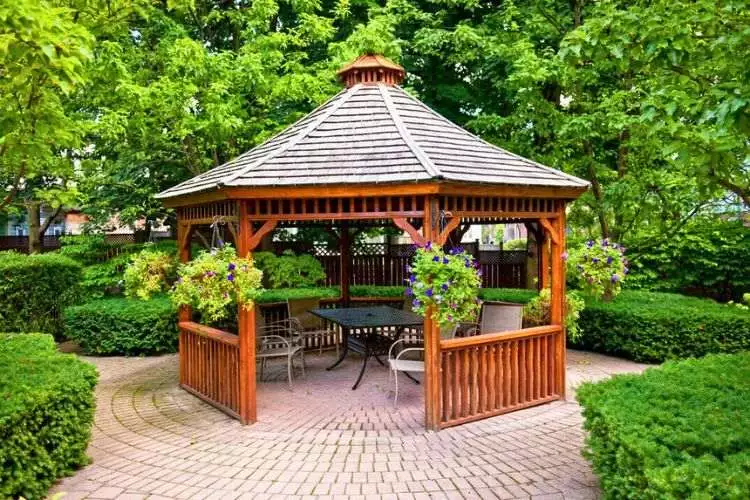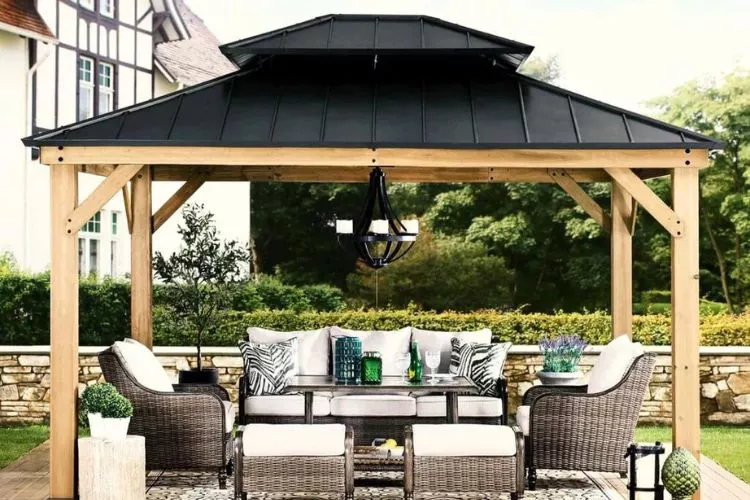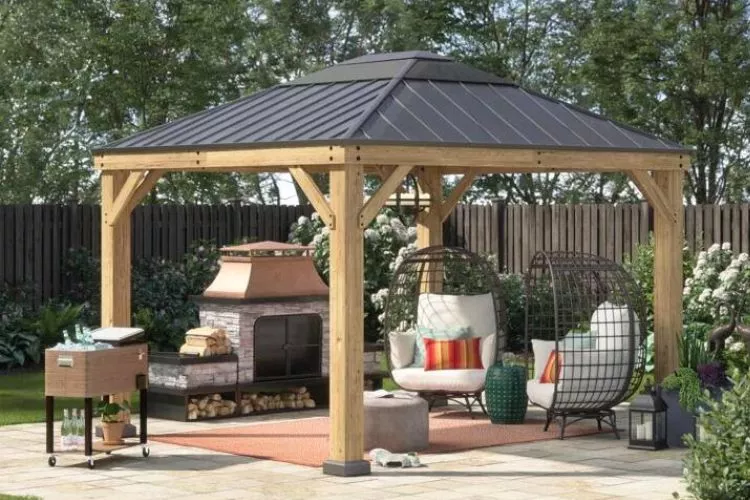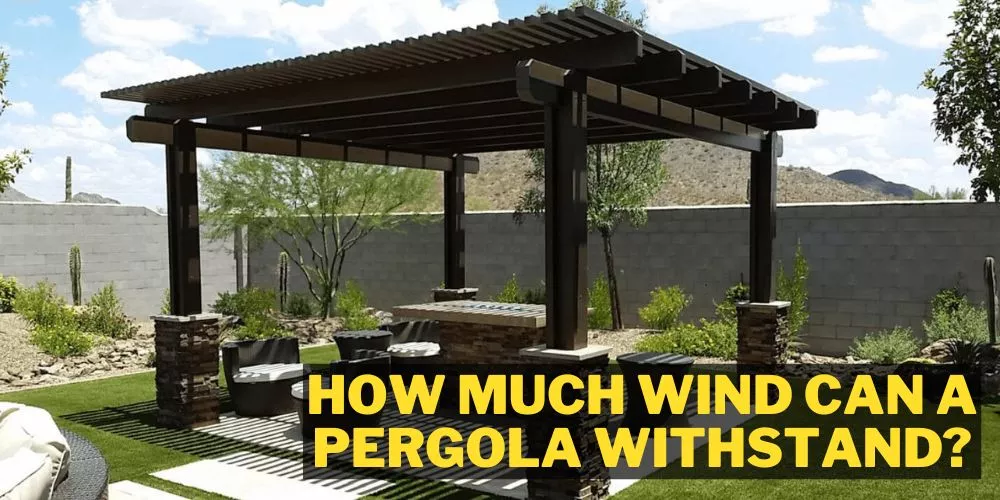When creating an enchanting outdoor retreat, nothing beats the charm and functionality of a gazebo. A gazebo is a versatile addition to your yard or garden as a place for relaxation, entertainment, or a centerpiece for landscaping. But an important thing to know is how tall should a gazebo be? Determining the right height for your gazebo isn’t just a matter of aesthetics; it’s a critical decision influencing comfort, accessibility, and compliance with local regulations.

I will be addressing your potential hurdles, and guiding you step-by-step towards making an informed decision about your gazebo’s height. By the time you finish reading, you’ll be ready to plan your gazebo confidently, ensuring it fits perfectly within your outdoor space.
How Tall Should a Gazebo Be? (Determining the Ideal Height)
Having discussed the various factors to consider when deciding on your gazebo’s height, it’s time to delve into what the ‘ideal height’ really means. The ideal height isn’t a one-size-fits-all answer; it’s a delicate balance between the standard height range, the gazebo’s function, and additional design considerations. Let’s explore these factors further.

1. Standard Gazebo Height Range
While there’s flexibility in choosing your gazebo’s height, it’s beneficial to know the standard height range as a starting point.
Overview of typical gazebo height range (e.g., 8 to 12 feet)
Gazebos typically fall within the range of 8 to 12 feet (approximately 2.4 to 3.7 meters). This range offers a good balance between providing ample headroom for standing and moving around while maintaining a cozy, intimate atmosphere.
Factors influencing the decision within the standard range
Several factors can influence where your gazebo falls within this standard range. For instance, the gazebo’s purpose and surrounding environment are key factors. A dining gazebo may require more height for comfort, whereas a gazebo meant as a tranquil reading nook may be on the lower end of the range to foster a cozy setting.
2. Tailoring Gazebo Height to Specific Functions
The function of your gazebo directly impacts the optimal height. Let’s look at common gazebo uses and the height considerations for each.
Height considerations for seating areas and lounging spaces
A gazebo primarily for seating or lounging doesn’t necessarily require as much height as a dining or entertaining space. In these cases, anywhere from 8 to 10 feet (around 2.4 to 3 meters) should provide a comfortable space.
Optimal height for a dining or entertainment gazebo
Dining or entertaining requires more height to accommodate standing guests and furniture like dining tables or barbeque grills. For such uses, you might lean towards the taller end of the spectrum, say 10 to 12 feet (approximately 3 to 3.7 meters).
Different height requirements for a decorative or standalone gazebo
For gazebos that primarily serve as garden features or decorative elements, the height should be determined more by its surroundings and how well it integrates into the overall landscape than by a standard range. These gazebos could be taller in open spaces or shorter if nestled amongst trees or other structures.
3. Additional Design Considerations
Beyond function, there are also aesthetic and design elements to consider when deciding on your gazebo’s height.
Balancing proportion and aesthetics with surrounding elements
The height of your gazebo should balance well with other elements in your yard or garden. A gazebo shouldn’t overpower smaller elements or be dwarfed by larger ones. It should feel like a cohesive part of your outdoor space, with its size in proportion to other structures and features.
Harmonizing gazebo height with nearby structures and landscape
The gazebo’s height should also harmonize with the landscape and other nearby structures. For instance, a gazebo near a single-story home or low shrubbery may look out of place if it’s excessively tall. On the other hand, a gazebo in an open space or near tall trees might seem too small if it’s on the lower end of the height range.
Factors to Consider When Determining Gazebo Height
Deciding on the appropriate height for your gazebo is not as straightforward as it may seem. It’s an intricate process considering various factors, from the gazebo’s primary use and location to adherence to local building codes and ensuring comfort and accessibility. Let’s explore these elements in detail.

Location and Functionality
Determining the function of your gazebo is the first crucial step. Whether for seating, dining, or a garden feature, your gazebo’s purpose significantly impacts its ideal height.
Determining the primary use of the gazebo (e.g., seating, dining, garden feature)
A lower height might suffice if you use your gazebo primarily for seating. However, if your gazebo is intended for dining or entertaining guests, you’ll want to ensure ample overhead space for standing and moving around comfortably, which might necessitate a taller structure. Gazebos serving solely as a garden feature may vary in height based on the aesthetic requirements and the scale of your garden.
Assessing the location and surroundings (e.g., landscape, nearby structures, sightlines)
The location of your gazebo also plays a crucial role in determining its height. A gazebo in an open area might be taller, taking advantage of unrestricted sightlines. At the same time, one near trees or other structures might need to be shorter to fit harmoniously within the environment. The grade of the landscape can also affect the gazebo’s height; for instance, a gazebo on a hill might require a lower roofline to blend seamlessly with its surroundings.
Building Codes and Regulations
Familiarity with local building codes and regulations is another essential aspect when planning the height of your gazebo. These regulations are there to ensure safety and aesthetic coherence within your community.
Familiarizing oneself with local building codes and regulations
Each locality will have specific codes and regulations concerning gazebo construction, including height restrictions. Researching these thoroughly or consulting with a local building official or contractor is essential to avoid any regulatory missteps.
Height restrictions and guidelines to adhere to
Building codes might dictate a maximum height for your gazebo, often tied to the structure’s distance from the property line. Sticking to these guidelines keeps you in line with the law and helps ensure your gazebo doesn’t overpower other elements in your outdoor space.
Comfort and Accessibility
While considering gazebo height, your gazebo should be comfortable and accessible to all potential users, keeping in mind individuals of different heights and those with mobility challenges.
Ensuring comfortable headroom for individuals of different heights
The interior height of your gazebo should accommodate individuals of different heights comfortably. A typical gazebo height ranges from 8 to 12 feet (about 2.4 to 3.7 meters). Still, you might consider going slightly taller to ensure all guests, even your tallest ones, can move around easily without feeling cramped.
Accessibility considerations for individuals with mobility challenges
If the gazebo is to be used by individuals with mobility challenges, consider the accessibility of the structure. This could mean designing a taller gazebo to accommodate anyone using a mobility device or ensuring no unnecessary barriers might obstruct their movement. Regardless of mobility level, every user should be able to enjoy the gazebo comfortably and safely.
Pro Tips for Determining Gazebo Height
To further assist you in deciding the best height for your gazebo, here are some pro tips from seasoned architects and contractors. These nuggets of wisdom, born from years of hands-on experience, can help ensure your gazebo is a perfect fit for your needs and landscape.

- Seek Professional Advice: While doing it yourself is a commendable endeavor, seeking professional advice from architects or contractors familiar with local regulations is wise. They bring a wealth of experience and can offer insights into height considerations you might not have thought of.
- Consider More Height: As a rule of thumb, consider going slightly higher than you initially planned. Extra headroom accommodates taller guests and avoids a cramped feeling. A gazebo should feel open and airy, not confined.
- Evaluate Weather Impact: Always factor in your local climate. Wind and weather conditions can influence your gazebo’s height choices. For instance, a lower gazebo might fare better in windy areas than a taller one.
- Visualize Your Gazebo: Lastly, make use of visual aids. Scaled drawings or 3D modeling can be immensely helpful in assessing different height options and how they impact the overall aesthetic of your outdoor space. These tools allow you to virtually ‘see’ the finished gazebo and make adjustments as necessary before construction begins.
These tips, combined with the comprehensive guide above, empower you to make informed decisions about your gazebo height, creating an outdoor haven that complements your home and lifestyle.
You May Also Find Useful: What Size Gazebo Do I Need?
Frequently Asked Questions (FAQs)
What are the common height restrictions imposed by local building codes?
Local building codes often impose height restrictions to maintain neighborhood aesthetics and safety. While specifics vary, many codes limit accessory structures like gazebos to around 15 feet (approximately 4.6 meters).
Should the gazebo height be proportional to the size of the structure?
Yes, the gazebo’s height should harmonize with its overall size. A balanced proportion creates a visually pleasing structure and ensures optimal functionality and comfort.
Can the height of the gazebo affect its stability?
Yes, a taller gazebo can potentially be less stable in high winds or severe weather. Therefore, consider your local climate and potential wind load when deciding the gazebo’s height.
Are there any recommended materials for constructing taller gazebos?
Sturdier materials like treated wood, metal, or reinforced vinyl are recommended for taller gazebos. These materials can better handle the increased structural demands of a taller gazebo.
What is the minimum & maximum height for a gazebo?
Generally, the minimum height for a gazebo is around 8 feet (approximately 2.4 meters) to ensure comfort. In contrast, the maximum height should be determined based on local building codes, typically around 12-15 feet (approximately 3.7-4.6 meters).
Conclusion:
In conclusion, determining the right gazebo height involves various factors like the gazebo’s purpose, local building codes, accessibility, and aesthetic considerations. While the standard range is typically 8 to 12 feet (about 2.4 to 3.7 meters), the ideal height should accommodate your unique needs and harmonize with your surroundings. Be mindful of weather impacts, use visual aids, and don’t hesitate to seek professional advice. We hope that this guide has been helpful. You can read about similar topics here on our website. Check back again soon for more.


